During Hollywood’s Golden Age the movies were marketed through the stars and their fashions. The visual presentation of these alluring features came in colorful posters and glossy photographs, all reproduced in magazines and newspapers. And before the stars’ romance could light up the screen (often continued off-screen), whether in romantic comedies or murder mysteries, they were photographed together in dual portraits.


In the day each studio had its own portrait gallery, where photographers were busy shooting the stars. “Stills” as they were called, were shot of each movie star. These photos were issued to fans and used for publicity and for fashion articles and movie magazines. The portrait photo was the most carefully handled of all stills, an art form crafted by photographers such as George Hurrell, Ernest Bachrach, Clarence Sinclair Bull, Eugene Robert Richee and others. Such portraits not only helped sell the picture, but also sold the star. And when romance was part of the movie, the dual portrait had to convey a strong attraction. The intimacy portrayed in the photo was a signpost to audiences signifying that whatever troubles the plot threw at them, the couple chemistry lit up the screen.


The dual portrait was tricky business. Each star needed to be prominently shown, with the all-important lighting capturing each of them individually – while displaying their mutual attraction. The best of these photographs are sublime. Like the film itself, the photo can give the illusion that we are peering into a very private and personal moment, with the photo freezing that image in time. In real life, then as now, the two stars may not have gotten along at all. Getting each of them in for a photo setting, where one or both may have agreements to approve the results before they were issued, added to the complexity of the job. But like the costume designers, the portrait photographers learned to work with each star. And the stars knew the results were important to their careers. Sometimes very opposite personalities worked unexpectedly well, like the light-natured, all-American Jean Arthur with the French romantic, but always serious, lead Charles Boyer, in History is Made at Night. In film plots opposites can often lead to trouble. In the dark pre-code Three on a Match, Ann Dvorak’s well-married character takes up with a small-time hood played by Lyle Talbot. She turns to drugs and comes to a bad end.

In Leave Her to Heaven, a film noir in blazing Technicolor, Cornel Wild falls hard for the siren call and alluring beauty of Gene Tierney. Little does he know that she will become morbidly jealous.

“My name is Tondelayo” is all Hedy Lamarr had to say in White Cargo to knock adventurer Walter Pidgeon off his feet. Billed by MGM as the most beautiful woman in the world, she didn’t need to do much acting, but don’t underestimate her intelligence.
Since the set-up for the portrait shot was complicated, and the cameras used were bulky, the screen lovers rarely peer into each other’s eyes. Often they seem to stare into the distance – firmly connected – yet dreaming their own dream. The photographer’s art was to capture that moment on photographic film – the double-visioned dream.

Gregory Peck and the Italian actress Valli starred in Alfred Hitchcock’s little known The Paradine Case. Peck’s aquiline features and Valli’s prominent cheekbones give a beautiful symmetry to this photo.
With the classic photo of Bogart and Bergman below we can relive the entire Casablanca film. Here they look off, he seemingly backwards at their time in Paris, she, apprehensive, worried about Laszlo getting caught, or perhaps who it is she will leave with?

When the screen lovers do stare into each other’s eyes, we can feel the intensity of the moment. It’s the moment before the kiss. These photos were usually taken on the set rather than in the portrait gallery. The set had more room for action, and a drama might soon unfold.

Joan Crawford and Clark Gable starred in eight movies together, in addition to having been actual lovers. Their early dual portraits usually display real heat. Although they were extras together in The Merry Widow (1925), Dancing Lady is their first starring movie together.

Gary Cooper and Barbara Stanwyck are another example of opposites attracting, at least in the film. In Ball of Fire, he was a straight-laced professor. She was a burlesque dancer. In real life he was 6ft 3. She was 5ft 4.
The classic The Thomas Crown Affair, starred Steve McQueen and Faye Dunaway. The cat and mouse story leads to the two on opposite sides falling in love. It’s a classic story that lead to a re-make.

The art and practice of the dual portrait is now largely lost. These images have a haunting beauty that was artfully captured on film. Love is eternal, and these actors in their youthful beauty and the photographers they worked with captured that essential truth.

Although movie posters still advertise new movies, the genre of romantic comedies and romances are largely gone. Some photos are still being taken on the set for advertising purposes but the idea of getting two actors to pose for a series of romantic photos is also unthinkable these days. Even in 1992’s The Last of the Mohicans, the captivating moment on screen was not captured in the photo above, where each actor seems already preparing for their movie trials and tribulations.
Views: 183














